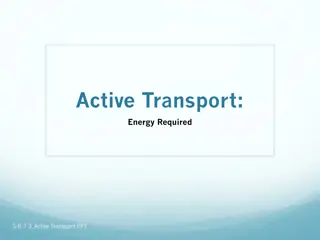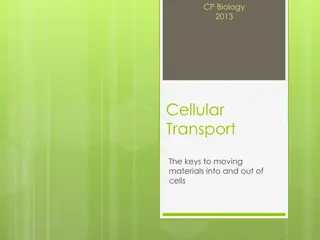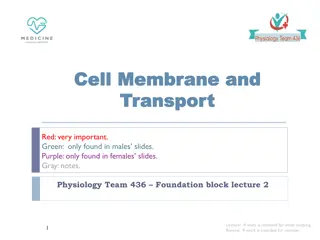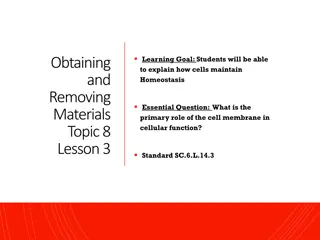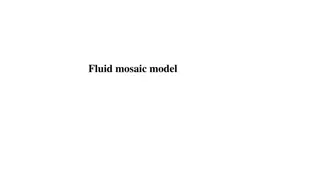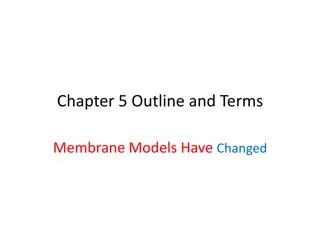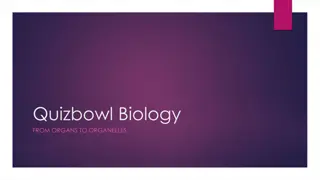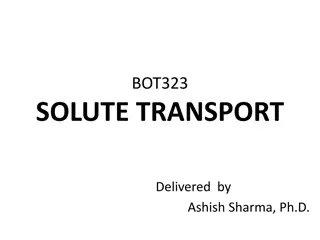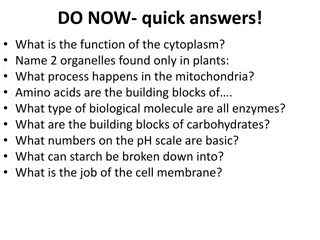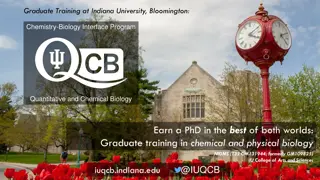Understanding Cellular Membrane Transport in Biology/Chemistry Interface 2
Explore the teachable unit on membrane transport in an introductory biology class for majors to understand how cells exchange substances with their environment. The unit covers selective membrane permeability, membrane transport mechanisms, proteins involved, physiological importance, and outcomes of disruption. A focus on secondary active transport helps clarify the energy source for moving molecules against concentration gradients.
Download Presentation

Please find below an Image/Link to download the presentation.
The content on the website is provided AS IS for your information and personal use only. It may not be sold, licensed, or shared on other websites without obtaining consent from the author. Download presentation by click this link. If you encounter any issues during the download, it is possible that the publisher has removed the file from their server.
E N D
Presentation Transcript
Biology/Chemistry Interface 2 Pump House Gang Carmen Domingo Christian Hansel Jennifer Breckler Kimberly Tanner Melina Hale Tom McKnight Wayne Versaw Coaches - Stacy Hagemeier and Mark Hens
Teachable Unit: Membrane Transport Overall goal: Students will understand how cells exchange substances with their environment. Setting: Introductory Biology class for majors ~150 students
Overall goal: Students will understand how cells exchange substances with their environment. Specific student learning outcomes for the unit: 1) Be able to explain the basis of selective membrane permeability and distinguish between passive and active mechanisms of membrane transport. 2) Be able to distinguish structural characteristics and functional roles of the various membrane transport proteins (i.e. carriers, channels, pumps) 3) Describe the physiological importance of membrane transport (i.e. energy considerations) 4) Predict the outcomes of disruption of various membrane transport systems
Relationship of our Tidbit to Learning Outcomes: 1) Be able to explain the basis of selective membrane permeability and distinguish between passive and active mechanisms of membrane transport. 2) Be able to distinguish structural characteristics and functional roles of the various membrane transport proteins (i.e. carriers, channels, pumps) 3) Describe the physiological importance of membrane transport 4) Predict the outcomes of disruption of various membrane transport systems
Rationale for a teachable tidbit When it comes to secondary active transport, many students have difficulty understanding the source of energy needed to move molecules against their concentration gradient
Bio 101 Today . Congratulations! Exam review
Exam 2, Question #4 What happens to glucose when the Na/K pump is blocked? A. No effect on glucose transport B. Glucose transport into the cell stops immediately C. Glucose flows out of the cell D. Glucose transport into the cell stops but not immediately
Exam 2, Question #4 What happens to glucose when the Na/K pump is blocked? A. No effect on glucose transport B. Glucose transport into the cell stops immediately C. Glucose flows out of the cell D. Glucose transport into the cell stops but not immediately 40 35 30 25 Percent 20 Q #4 15 10 5 0 A B C D
http://www.stolaf.edu/people/giannini/flashanimat/transport/secondary%20active%20transport.swfhttp://www.stolaf.edu/people/giannini/flashanimat/transport/secondary%20active%20transport.swf
What happens to glucose when the Na/K pump is blocked? Role Play A tragedy in three acts
G G BACK (outside cell) G G G G G G G PROLOGUE G G G G G G G G Tables (membrane) Aisle (Na+/K+ Pump) Aisle (Glucose Trans) Na+ Na+ Na+ Na+ Na+ G Na+ Na+ Na+ Na+ Na+ Na+ (HUGE amounts of Glucose) Na+ Na+ Na+ Na+ Na+ Na+ Na+ Na+ Na+ FRONT (inside cell) Na+ Na+ Na+ Na+
G G BACK (outside cell) G G G G G G Na+ G Na+ G G Na+ Na+ G Na+ G Na+ G G Na+ G G Tables (membrane) Aisle (Na+/K+ Pump) Aisle (Glucose Trans) ACT 1 Build gradient QuickTime and a decompressor are needed to see this picture. ATP ADP Na+ G G Na+ (HUGE amounts of Glucose) Na+ Na+ Na+ Na+ Na+ Na+ Na+ Na+ Na+ Na+ FRONT (inside cell) Na+ Na+ Na+ Na+ Na+
Na+ G G BACK (outside cell) G G Na+ Na+ G G Na+ Na+ G G Na+ G Na+ Na+ Na+ Na+ G G Na+ Na+ G Na+ G Na+ G Na+ G Na+ G G Na+ Na+ Tables (membrane) Aisle (Na+/K+ Pump) Aisle (Glucose Trans) END ACT 1 Gradient established Na+ Na+ QuickTime and a decompressor are needed to see this picture. ATP ADP G G (HUGE amounts of Glucose) FRONT (inside cell)
BACK (outside cell) Na+ Na+ Na+ G G Na+ Na+ G Na+ Na+ G Na+ Na+ Na+ Na+ G G Na+ G Na+ G Na+ G G Na+ Tables (membrane) Aisle (Na+/K+ Pump) Aisle (Glucose Trans) ACT 2 glucose transport G G Na+ Na+ QuickTime and a decompressor are needed to see this picture. ATP G ADP G G G G Na+ Na+ Na+ Na+ G (HUGE amounts of Glucose) Na+ Na+ G FRONT (inside cell) Na+
BACK (outside cell) Na+ Na+ Na+ G G Na+ Na+ G Na+ Na+ G Na+ Na+ Na+ Na+ G G Na+ G Na+ G Na+ G G Na+ Tables (membrane) Aisle (Na+/K+ Pump) Aisle (Glucose Trans) ACT 3 tragic inhibition G G Na+ Na+ G G G G G Na+ Na+ Na+ Na+ G (HUGE amounts of Glucose) Na+ Na+ G FRONT (inside cell) Na+
BACK (outside cell) Na+ Na+ G Na+ Na+ G Na+ G Na+ Na+ Na+ G G Na+ Na+ G G Na+ Tables (membrane) Aisle (Na+/K+ Pump) Aisle (Glucose Trans) End of ACT 3 QuickTime and a decompressor are needed to see this picture. G G G Na+ Na+ Na+ Na+ G Na+ G G G G Na+ Na+ Na+ G (HUGE amounts of Glucose) Na+ Na+ Na+ G G G FRONT (inside cell) Na+
http://www.stolaf.edu/people/giannini/flashanimat/transport/secondary%20active%20transport.swfhttp://www.stolaf.edu/people/giannini/flashanimat/transport/secondary%20active%20transport.swf
Questions to discuss in groups: 1. What is the direct energy source in a cell used to transport glucose across the membrane against its concentration gradient? 2. What happens to glucose when the Na/K pump is blocked?
Question #4 from exam 2 What happens to glucose when the Na/K pump is blocked? A. No effect on glucose transport B. Glucose transport into the cell stops immediately C. Glucose flows out of the cell D. Glucose transport into the cell stops but not immediately 40 35 30 25 20 Q #4 15 10 5 0 A B C D
Overall goal: Students will understand how cells exchange substances with their environment. Specific student learning outcomes for the unit: 1) Be able to explain the basis of selective membrane permeability and distinguish between passive and active mechanisms of membrane transport. 2) Be able to distinguish structural characteristics and functional roles of the various membrane transport proteins (i.e. carriers, channels, pumps) 3) Describe the physiological importance of membrane transport (i.e. energy considerations) 4) Predict the outcomes of disruption of various membrane transport systems


